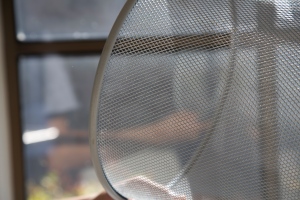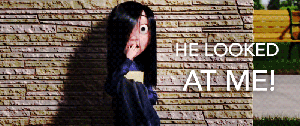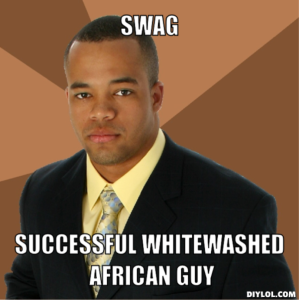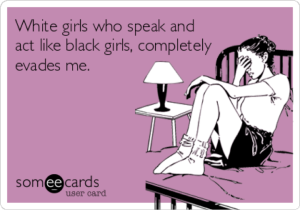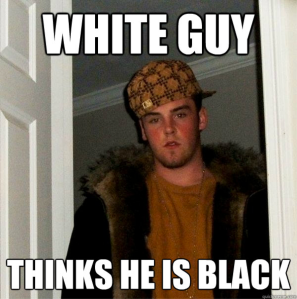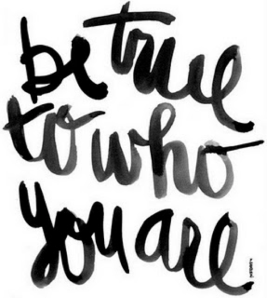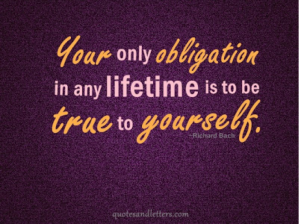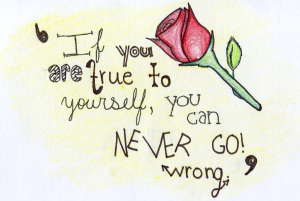These posts are best enjoyed chronologically. Start with “Copycat: Good, Bad, or Neither” and end with “Jet Lag”
Uncategorized
Jet Lag
Growing up, I never realized the differences between people of other races. For example, I would say, “Oh, that’s an African-American, that’s a Hispanic girl, and oh, that’s a white kid.” I would never think about the fact that maybe they came from different countries. Of course, being a Chinese American, I would always endeavor to figure out the specific nationality of any Asians that I met, but when it concerned other races I did not bother. And for some reason, this applied especially to people with African heritage. Anybody who was black automatically became African-American. Now that I am older, I realize that it is improper to assume like I did when I was younger. Instead of a black person being African-American, they could actually be from Senegal or Liberia. Or from Australia for that matter. So how are they related? Is it because they all came from Africa? They all started from somewhere and immigrated to somewhere else?
A representation of the black diaspora.
In “The Practice of Diaspora,” Brent Hayes Edwards describes how black people throughout the world are related. He uses the French word decalage to describe the black diaspora,
“Decalage is one of the many French words that resists translation into English…It can be translated as ‘gap,’ ‘discrepancy,’ ‘time-lag,’ or ‘interval’; it is also the term that French speakers sometimes use to translate “jet lag.” In other words, a decalage is either a difference or gap in time (advancing or delaying a schedule) or in space (shifting or displacing an object)…the verb caler means “to prop up or wedge” something (as when on leg on a table is uneven). So decalage in its etymological sense refers to the removal of such an added prop or wedge. Decalage indicates the reestablishment of a prior unevenness or diversity; it alludes to the taking away of something that was added in the first place, something artificial, a stone or a piece of wood that served to fill some gap or rectify some imbalance.” (Edwards, 13-14)
Some simple examples of decalage. Gaps inherent in the structure.
If decalage is a gap, and not only that but also the restoration of a gap or a discrepancy, how can Edwards be using it to describe black diaspora, something that is meant to bring together those with African heritage all over the world into a community?
First, let us examine the wedge that must be removed if Edwards’ theory of decalage is true. Many people assume that black diaspora for all black people is the same (like I did before). They assume that all black people have the same history of forced immigration to the Americas. This is due mainly to the fact that cultures of black internationalism resulting from diaspora can only be viewed in translation (Most people of African descent cannot speak or write in English). And who translated these stories, these histories of black people? White European or Americans. Thus, our view of the black diaspora has been smoothed out to an artificial sameness because many important stories and experiences of African immigrants have been lost in translation. White historians have overgeneralized the black diaspora, and thus have taken away the differences intrinsically found in black immigrant history. Edwards challenges us to remove the wedge, if you will, and restore the gap. This gap describes how black diaspora truly is.
Edwards explains how diaspora demonstrates dissimilarities,
“….diaspora points to difference not only internally (the ways transnational black groupings are fractured by nation, class, gender, sexuality, and language) but also externally; in appropriating a term so closely associated with Jewish thought, we are forced to think not in terms of some closed or autonomous system of African dispersal but explicitly in terms of a complex past of forced migrations and racialization.” (Edwards, 12)
It is very clear that those with African heritage have been dispersed from Africa in many different situations and through different forms. Take, for example the Africans that were sold as slaves to the Americas versus the Africans that were sold as slaves to Europe. Those people are now very different from each other, not only because of their past, but also because of their present. Those in Europe will speak French, Italian, and German, among other languages. Those in the Americas will speak English, Portuguese, and Spanish, among others. Within the groups of the European blacks and American blacks, there are even more differences. Take the American blacks for example. Some are considered Hispanic while others are considered African-American. Some eat “soul food” while others dine on Caribbean cuisine.
In Americanah, by Chimamanda Ngozi Adichie, Ifemelu returns to her original home in Nigeria after spending many years in the United States:
“When had shopkeepers become so rude? Had buildings in Lagos always had this patina of decay? And when did it become a city of people quick to beg and too enamored of free things? “Americanah!” Ranyinudo teased her often. “You are looking at things with American eyes. But the problem is that you are not even a real Americanah. At least if you had an American accent we would tolerate your complaining!” (Adichie, 475-476)
Even though Ifemelu did not grow up in the United States, living in the US for more than just a few years would change her. She would grow used to the items and attitudes in the United States. How could living in a different place not change a person? That change in Ifemelu is now a part of her, and it should be a part of her because it is natural. The same goes for people who are part of the black diaspora. It is natural for them to have differences from each other.
Yet still some people still say that a community is supposed to thrive on shared characteristics. That a cultural identity, in this case, a black one, is supposed to be based on the fact that all black people came from Africa.
Edwards uses Stuart Hall to contend this belief,
“Hall himself explicitly begins to theorize in the late 1980s as a frame of cultural identity determined not through “return” but through difference: ‘not by essence or purity but by the recognition of a necessary heterogeneity and diversity; by a conception of identity which lives with and through, not despite, difference.’” (Edwards, 12)
Hall is explaining that cultural identity is not defined only by a shared sameness. Instead it is difference that can make a community and an identity richer.
In Americanah, Ifemelu creates a blog, reading the comments from one of her posts:
“The first commenter wrote: Rubbish post. Who cares? The second wrote Thank God somebody is finally talking about this….By the sixth day, the blog had one thousand unique visitors. Ifemelu moderated the comments, deleting anything obscene, reveling in the liveliness of it all, in the sense of herself at the surging forefront of something vibrant.” (Adichie, 520)
In this instance, a community is created out of difference. Although the people reading Ifemelu’s blog have many different opinions, their discussion of opposing views bring them together. This demonstrates a community borne out of disagreements.
Another community that requires difference as an integral part of it is the Democratic political party in the United States. The people in the party are the same because they share the same political beliefs. Yet they are very different. There are democrats in California, there are democrats in Maine, and yes, there are even democrats in Texas. They are white, black, Hispanic and Asian. They speak different languages, grew up in different households. Some of them may not have even grown up in the United States. They ascribe to many different religions, from Christianity to Buddhism. Many of them do not even hold the exact same political beliefs. Yet without these differences, the Democratic party would not be what it is today. It might not even exist-for if they wanted a homogenous population, the party would not have enough supporters. In the same way, the community formed by the black diaspora is the same because everyone in it has roots in Africa, but it cannot exist without the differences within it.
Edwards clarifies the idea of decalage further, and relates it to the dissimilarities found in the African diaspora,
“If a discourse of diaspora articulates difference, then one must consider the status of that difference-not just linguistic difference but, more broadly, the trace or residue, perhaps of what resists or escapes translation…Such an unevenness or differentiation marks a constitutive decalage in the very weave of the culture, one that cannot be either dismissed or pulled out.” (Edwards 13)
Decalage becomes a very good description of black diaspora. The differences between the people that are a part of the diaspora and the discrepancies within it – resulting from what eludes translation – are embedded in the African diaspora itself. The dissimilarities between those involved in the diaspora result from obvious histories but also from subtle and invisible effects. These invisible effects make up the decalage that is embedded within cultural identity and the African diaspora. This gap, resulting from these invisible effects, in the structure of black diaspora is hard to explain, just as it is hard to translate decalage from French to English.
The removal of the improper view of black diaspora as uniform allows us to understand black international culture as decalage. A gap, but a gap that is part of the character of black diaspora, and a gap without which black diaspora as we know it would not exist.
A Game for the Ages: Hide and Go Seek
We’ve all played it. Hide and go seek. Do you remember the thrill of hiding from the seeker? The adrenaline rush that you received when the seeker came looking for you? Did you treasure that small, secret hiding place in which you stayed? I know that I did. Every time that I would play hide and go seek I would sneak into a little cabinet in the corner of my house, praying that no one would find me. I wanted to feel like I had disappeared into thin air. That I became invisible.
In Anne Cheng’s essay, “Passing, Natural Selection, and Love’s Failure: Ethics of Survival from Chang-rae Lee to Jacques Lacan,” she starts by quoting Roger Caillois in his work, The Mask of Medusa.
“Camouflage is the blending of the animal into the pattern, the environment; it is a search for invisibility…With men too, invisibility is an ever recurring desire.” (Cheng, 553)
Invisibility is an ever recurring desire. There are many examples that prove this statement true. The ancient Greeks associated the ability to become invisible with a hero. In Greek mythology, Perseus uses a cap of invisibility to escape from the Gorgon sisters. He was legendary for being the first hero whose exploits led to the defeat of monsters. In the iconic Lord of the Rings trilogy, by J.R.R. Tolkien and first published in 1955, Frodo Baggins is entrusted with a ring that holds mysterious power. Among one of its powers is the ability to make the wearer invisible. The ring is also addictive and it becomes an obsession for the wearer. Although it may not have been the author’s original intention, the ring’s ability to make the wearer invisible and obsessed with it, shows a correlation between fascination or preoccupation and invisibility.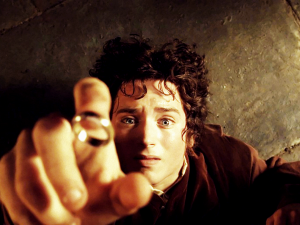
The preoccupation with the power of invisibility can be seen on the big screen also. In many superhero movies, there are heroes with powers of invisibility. In the hugely popular movie, The Incredibles, the daughter, Violet, has the power to turn invisible. What’s more is that she does not just use her power for defeating villains-she also uses in her regular high school life. When I first saw that Violet used her powers of invisibility to sneak around in her school, I wished so badly that I could become invisible too. Would it not be thrilling to be a fly on the wall? To be so hidden that people would not be able to find you no matter how hard they tried?
Violet right after a boy (that she had a crush on) looked at her when she was invisible.
Roger Caillois asserts that the desire for invisibility cannot be the same as a desire for a mode of survival. In other words, invisibility is not used for survival. If invisibility is not a survival mechanism, but rather used for something else (like how Violet uses her invisibility even when she is not fighting her nemesis), then why do people desire it?
Anne Cheng states,
“Even more intriguingly, according to Caillois…’Above, and under disguise, I postulate a fascination with the Other, suggesting this as the reason for mimicry and adaption [sic]’ (86)…Being outside or beside oneself, it would appear, provides an inestimable source of psychic pleasure and nourishment.” (Cheng, 554)
Mimicry, a disguise, the blending of a subject into its environment, is the same as invisibility. As humans, we find pleasure in being able to blend in. There are many possible reasons for why this may be true. Some reasons are simple: one reason being that we like the feeling of wanting to belong, to not stand out. Cheng points to this reason,
“This “fascination with the Other” conditions social desire as such, but it also speaks to an imbricated ontic pleasure.” (Cheng, 554)
The fascination with the Other means an interest in things that are not yourself. Ontic relates to existence as real rather than phenomenal. This statement is pointing out that in addition to a desire to connect to others, the preoccupation with mimicking others is borne out of a desire for a regular rather than extraordinary existence.
Other plausible reasons for why it is pleasurable to mimic others and blend in are more complicated. Instances where a subject employs mimicry for no apparent reason except for pleasure abound. Take, for example, Smiley and his friends in Cary Fukunaga’s film, Sin Nombre. In the film, Smiley becomes a part of the Mara Salvatruchas, a dangerous gang in Mexico. The leader of the gang gives Smiley a gun so that he can murder a man. There is a certain scene where Smiley is spending time with his friends, who are not in the gang, and he shows them the gun. They all say, “Cool!” and marvel at his increased power. They also play with his gun and imitate being gang members with it. Why did Smiley’s friends do this? While Smiley did need to have a gun to survive (he was threatened by the gang), they did not need guns. So why did they mimic him? They held a fascination for him, a fascination for his life as a gang member. This correlates to an innate preoccupation with the Other that Caillois explains. By mimicking him, they did not gain anything except for their own pleasure. Perhaps mimicry is pleasure because you can pretend that you have something that, in actuality, you do not have. The young boys, naively, saw Smiley’s gun as a symbol of masculinity, strength, and adventure. Thus, they found satisfaction and enjoyment in pretending to possess these different characteristics.
Another very plausible reason for why it is quite enjoyable to pass yourself off as someone else is because you want to escape from yourself. Charles Dickens himself said,
“I want to escape from myself. For when I do start up and stare myself seedily in the face, as happens to be my case at present, my blankness is inconceivable-indescribable.”
Thus passing as something else can give someone great, indescribable pleasure, because for those moments, they can find liberation from their own life.
There are many examples of people who turn to performance to escape from their own personality or life. Take for example, Beyonce. In multiple interviews she has stated that she has an alter ego when she performs. This alter ego, which she names “Sasha Fierce”, gives herself the bravery to be free and sexy during her performances. Otherwise, she says, she is normally a very shy person. It is very interesting how she performs in two different aspects. Not only does she perform her music, but within that performance there is another performance in which she acts like a different person.
Mankind’s attraction to the idea of pretending to be somebody else, to the game of hide and seek, can be explained by Cheng’s theory. She argues that there is a type of euphoria that is found in displacing oneself. Numerous examples in literature and in popular culture support this idea, demonstrating the “delirium of perfection in mimicry.” (Caillois) From authors to musicians, all have perpetuated this theme, which can be seen in ancient Greece and modern America.
So why is mimicry often looked upon with disdain? It brings pleasure to the performer, and becomes a way for the performer to relate to others, take on desired characteristics, and escape from himself among other things. In this aspect, a performance given can provide insight into the performer’s emotions and true feelings, allowing that performance to take on important meaning.
Copycat: Good, Bad, or Neither?
“You’re such a copycat!”
My words, spoken, 10 years ago, in a moment of anger against my brother, demonstrates a particular attitude within our culture. I was furious that my brother would try to copy my clothing, that he would attempt to imitate me. Perhaps it was because I had taken such care in picking out my outfit that it seemed unfair that he would be able to wear it also. Perhaps I felt like less of an individual when my brother tried to blend in with me. Perhaps I was so upset because I believed that he was not being himself, was not truly becoming his own individual.
You see, society often views “copycats” in bad light. Samsung was sued and found guilty of copying Apple’s iPhone design. “Fake cultural foods” are apparently disturbing and appalling to those who know “authentic food.” (I grew up in a Chinese household, and every time we would walk by a Panda Express restaurant, my parents would shake their heads in shame.) Fake cashmere can never compare to real cashmere. But the most controversial copycats that exist are people. The media sensationalizes this. Take, for example, the many speculations about which celebrities underwent plastic surgery to attain “fake” physical features. Social media is no exception. Just note the many jokes and circulated pictures about “whitewashed” Asians, Blacks, or Hispanics (whitewashed means that they act and do everything like white people). They are “fake” white people. “Wannabes.”
Many people start campaigns or post “inspiring” messages to help people “become less fake.” There is an entire tag about it on Tumblr:
Most notable are: “I’m one of those people who like to have fun without needing to act like somebody else while I am.”
“We live in a world full of people pretending to be something they’re not. Don’t be one of them.”
“Don’t be a fake. Because everyone likes the original.”
Why all of the campaigning? What is so bad about pretending to be something that you are not? One of the biggest reasons why people may believe this is true is because when you are pretending to be something that you are not, you are not being true to yourself.
But what does it mean to be yourself? Does it just mean to not be somebody else?
In “Passing, Natural Selection, and Love’s Failure: Ethics of Survival from Chang-rae Lee to Jacques Lacan,” Anne Cheng, a professor at Princeton University who specializes in race studies and psychoanalytic theory in 20th century American literature, delves into the question of true vs. fake. Authenticity vs. performance. Cheng starts off her essay by referencing Roger Caillois, a social anthropologist. Cheng writes,
“Roger Caillois studies a phenomenon that the doctrine of natural selection fails to explain: those instances of mimicry in insect and animal life where survival does not seem to be the primary objective…In doing so, his thesis unveils and critiques the utilitarianism underlying the principle of selection…By replacing the biological and pragmatic motivations for passing with instinctual and social drives, Caillois opens up a whole new dimension to the business of mimicry.” (Cheng, 554)
There are instances in the wild where an animal’s camouflage or mimicry does not aid its survival. Take, for example, this chameleon:
 This colorful display does not help the chameleon stay hidden from predators. Why does it use this disguise?
This colorful display does not help the chameleon stay hidden from predators. Why does it use this disguise?
Or this fly that is camouflaged as a bee:
Clearly, its disguise as a bee did not aid in its survival, so why does it mimic bees?
Caillois’ argument is that mimicry, the act of imitating someone or something, is not necessarily only used for staying alive. Instead, mimicry may help an animal relate to others of its kind, or it may just be something that the animal instinctually does or enjoys. Then what does it mean for humans to imitate others, to perform, if we are not using performance as a survival skill?
Anne Cheng writes,
“In addition to the euphoria of self-displacement, invisibility appears to afford all kinds of subjective realizations, from physical to moral actualization. Self-erasure and fulfillment fuse. It is through spectacularization that the self achieves invisibility…The subject effects mimicry in order to lose, rather than save, itself and, in doing so, finds itself.” (Cheng, 555)
By invisibility, Cheng is referring to a human’s camouflage- the need to blend in with the crowd. Being ordinary instead of extraordinary. It is, for those who are different from others, being “fake.” Cheng also brings up a fascinating point. The idea that someone will attempt a performance to lose himself, but by losing himself, somehow he finds himself. Let’s apply this to real life, shall we? Say we take Wenyuan, an immigrant from China. He desperately wants to forget the differences between himself and people in America. He doesn’t enjoy the fact that his eyes are different and his hair is different and his skin is different. So he changes. He puts on a mask. Dyes his hair, changes his clothes, wears colored contact lenses. Becomes friends with Americans. Many would call him a fake American. But now that he is outside of himself, he can clearly see how he was before. He can see the differences in his new life and in his old life. Without his performance, he would never have been fully aware of who he is.
Now the question to ask is, who is Wenyuan? Is he the immigrant from China pretending to be American? Is he a man looking at his own performance? Or is he the man performing? Is he the performer looking at his former self? These questions blur the line between essence and camouflage, because watching the act and doing the acting both describe a person’s being.
In lieu of this idea Cheng asserts,
“Caillois’s study suggests that subjectivity might itself be such a performance. The philosophical and political quandary posed by assimilation (and other acts of “passing”) may not be about whether it is right or wrong to act like someone else but rather about whether acting like yourself (here the idiom is itself revealing) may be fundamentally the same as acting like someone else.” (Cheng, 556)
Cheng is asserting that the question that should be posed about cases of mimicry is not whether it is okay or not okay to “be fake” but rather, whether acting like yourself is identical to mimicking someone else.
In Native Speaker, Henry Park begins a job to spy on a politician named John Kwang. When reflecting back on the experience, he says, “I will say again that none of this was my duty. My job, which I executed faithfully, was never to spy out those moments of his self-regard, it was not to peer through the crack of the door and watch as he bore off each successive visage….Through events both arbitrary and conceived it so happened that one of his faces fell away, an then another, and another until he revealed to me a final level that would not strip off. The last mask.” (Lee, 141).
This description so beautifully describes Cheng and Caillois’ argument: that being and disguise are intimately connected. John Kwang was a man that wore many masks, and in the end, when his last visage was revealed, it was still a mask. It was not his face, but a cover-up, a disguise. Camouflage. In the end, his disguise and himself were one and the same.
Another example from Native Speaker that demonstrates this point is when Henry Park is supposed to be performing as a patient for a psychiatrist. Although he has written up his pretend life and memorized it, he still cannot help himself from weaving his own life into the stories that he tells the psychiatrist. (Lee, 206-207).
It was impossible for Henry to separate his fake self from his real self. Just as it is impossible to draw a distinction between a person’s being and his disguise. So when people say, “Stop being fake, just be yourself,” is that correct? We should not treat a person’s disguise as a demeaning exercise of being inauthentic. Nor should we treat it as a denial of self.
So you tell me, do you still think that being called a copycat is an insult, or is it just a statement of being?

